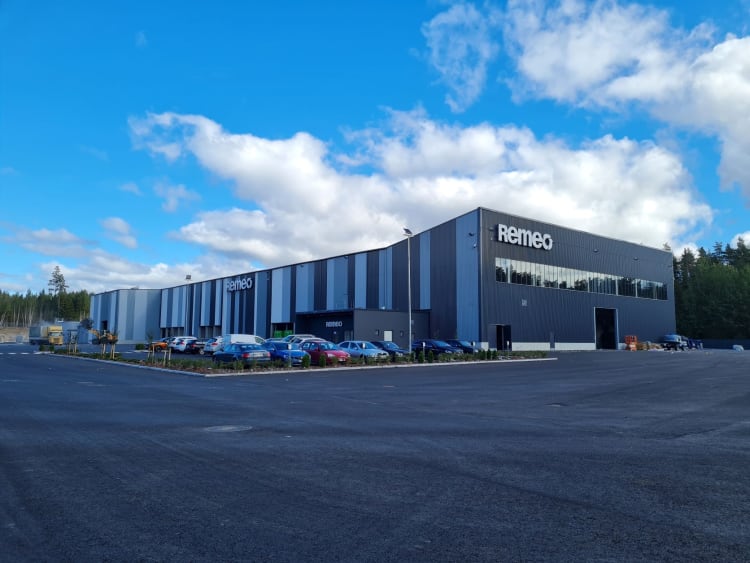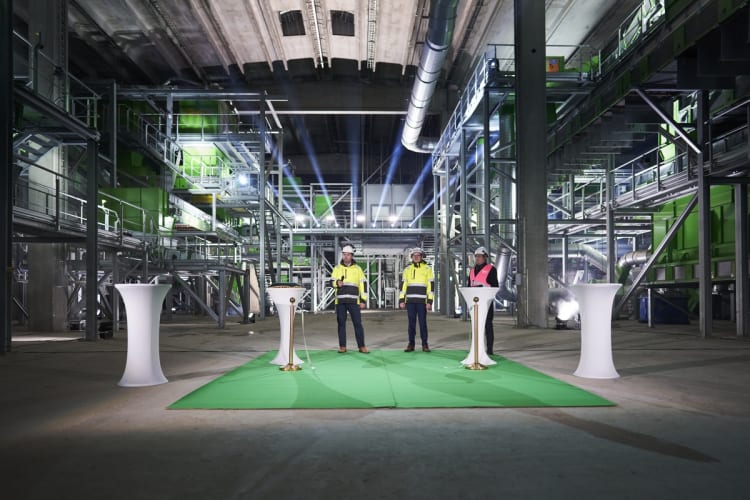
Stadler and ZenRobotics have built the pioneering new sorting plant with Remeo Oy, a Finnish company specializing in environmental management. Stadler designed the Materials Recovery Facility (MRF) in collaboration with Remeo and built it, while ZenRobotics supplied AI-based robotics waste sorting technologies. The facility, located in the Greater Helsinki Region in Finland, stands out not only for the state-of-the-art Artificial Intelligence (AI) technology, cutting-edge processes, and high level of automation, but also for integrating Commercial & Industrial (C&I) and Construction & Demolition (C&D) waste lines in the same plant - an industry first. The facility was completed ahead of schedule, despite the difficulties created by the Covid-19 pandemic - an achievement that is testament to the successful collaboration between Remeo, Stadler and ZenRobotics.
The new Remeo MRF was inaugurated on 14 February 2022 with a ribbon-cutting ceremony hosted by Remeo’s CEO Johan Mild and Business Director Mauri Lielahti. The Finnish Minister of Economic Affairs, Mika Lintillä cut the ribbon, declaring the facility officially open, and highlighted the significant leap forward that the innovative facility constitutes for the Finnish circular economy. A lights and music show symbolized the new era of circular economy in Finland and the innovations in this field. The event was livestreamed due to Covid-19 restrictions. The online audience also viewed footage of the facility’s construction and a virtual tour of the premises.

A unique design challenge: two plants in one, high automation
The new Remeo MRF presented unique and complex design challenges for being the first of its kind, combining a C&D plant capable of processing 30 t/h and a C&I plant with 15 t/h capacity, and its high level of automation. Resolving them required the best ingenuity and innovative thinking from Remeo, STADLER and ZenRobotics, as well as an exceptionally close collaboration among the partners.
“The combination of our experience with the C&D line, STADLER’s solid familiarity with the C&I line and ZenRobotics’ impressive knowledge of robotics made this an excellent co-operation with the best results,” Mauri Lielahti, Business Director, Processing at Remeo. “We appreciated STADLER’s capability to be innovative, their willingness to seek new solutions and that they were ready to listen to the customer’s needs. We have been working closely with ZenRobotics since 2014 and have a continuous development cooperation. Thanks to the knowledge we acquired on our older recycling facility, we knew what we should and should not do. It has been easy to work with them.”
The result of this collaboration is a design that “combines ballistic separators, screening drums, 3D drums, optical sorters, air separators, sorting robots, magnets, eddy-currents as well as the ZenRobotics robots, making it the most advanced waste sorting facility in the European Union,” says Nikolaus Hofmann, Sales Engineer at STADLER.
Juha Mieskonen, Head of Sales at ZenRobotics, adds: “The Remeo facility is equipped with 12 robot arms that pick objects from bulky C&D waste that weigh up to 30 kilograms and together perform up to 24,000 picks per hour. In other words, the robots do all the heavy lifting that’s neither safe nor feasible for humans. They sort multiple fractions on the spot, including different qualities of wood, metals, stone and plastic. The robots can be trained to recognize new fractions if needed, thanks to various sensors and artificial intelligence.
The facility integrates two different processing lines and features two consecutive robot systems on each line. It’s the largest fully roboticized MRF of its kind, which brought new operations and safety aspects to take into consideration in the design.”
“The most innovative aspects of the design can be described with the ‘Form from Function’ principle,” explains Nikolaus Hofmann. “The function of the lines was the driver in every design decision. For example, C&D waste tends to clog, especially at 90-degree transitions of the conveyors, so we eliminated them in the design as much as possible. To accommodate this, we designed a narrow and long building rather than a square structure.”
This approach to design extended to looking at the best solutions for maintenance, “in order to ensure a reliable and safe sorting facility for the future,” says Nikolaus Hofmann. “The layout is designed for easy maintenance, with almost every motor being accessible from walkways and maintenance platforms. The layout groups similar equipment together where possible and allows future possibility of extension. The dedusting system with multiple suction points across the whole plant and two large filter units installed outside the building further adds to the plant’s cleanliness.”
This “Form from Function” approach has proved effective in translating the customer’s demands into a design that fully meets their expectations: “The quality, usability and maintainability are excellent. We appreciate the appropriateness of the purpose of solutions and that the user perspective is taken into account,” comments Mauri Lielahti.

Mauri Lielahti, Joan Mild, Finnish Minister of Economic Affairs, Mika Lintilä. Photo by Esko Tuomisto


